An Intermediate Timer Event pauses a Case of a Process until a specified date or time. Once that time is reached, the event triggers automatically, allowing the workflow to resume.
Use this object when you need to delay a Request for a set period. For example, you can configure it to pause a Request for 30 days after services are rendered, giving time to receive an invoice from the customer before proceeding.
Add an Intermediate Timer Event to a Process
Permissions
Your user account or group membership must have the following permissions to configure an Intermediate Timer Event object in the Process model unless your user account has the Make this user a Super Admin setting selected:
Processes: Edit Processes
Processes: View Processes
See the Process permissions or ask your Administrator for assistance.
Add an Intermediate Timer Event from one of the following locations in the Process Modeler:
Object Panel: Located to the left of the Modeler, the Object Panel contains various process modeling objects.
Object Bar: Located at the bottom of the Modeler, the Object Bar contains pinned modeling objects for quick access.
Follow these steps to add an Intermediate Timer Event object from the Object bar to the Process model:
Ensure that the object is pinned to the Object bar. If not, see instructions to pin it.
In the Object bar at the bottom center, click the object's icon.
Click the location in the Process model to place this object. Follow these guidelines when placing this object:
If your process has a Pool object, the object cannot be placed outside of the Pool.
To place this object between two existing objects, follow these instructions.

Follow these steps to add an Intermediate Timer Event from the Object panel:
Ensure that the Object panel is visible. If not, click the Add icon
 from the Object bar at the bottom.
from the Object bar at the bottom.Click the Intermediate Event object
 from the Object panel to select it.
from the Object panel to select it.Click the location in the process model to place this object. Follow these guidelines when placing this object:
If your process has a Pool object, the object cannot be placed outside of the Pool.
To place this object between two existing objects, follow these instructions.

Replace an Intermediate Timer Event Object with a Different Object
After an Intermediate Timer Event object is added to a process model, you may replace it with one of the following:
Follow these steps to replace an Intermediate Timer Event object with a different Intermediate-type event object:
Select the Intermediate Timer Event object.
Click the Objects icon. The Objects drop-down menu displays the Intermediate-type event objects.
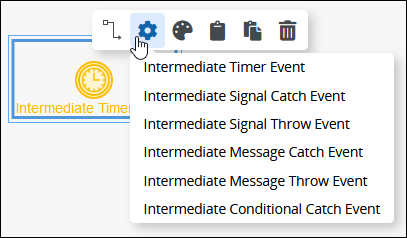
Select the new object type. The Change Type screen displays to confirm replacing the currently selected object.
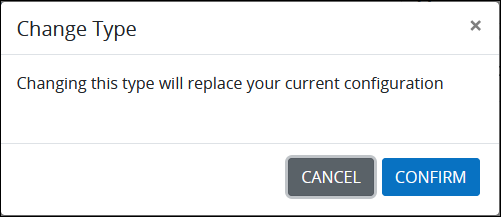
Click Confirm. The new object replaces the Intermediate Timer Event object with its default settings and color.
Settings
The Intermediate Timer Event object has the following configurable settings:
Configuration panel
Timing Control panel
Documentation panel
Advanced panel
Configuration Panel Settings
Edit the Object Name
An object name is a human-readable reference for a Process object. Process Modeler automatically assigns the name of a Process object with its object type. However, an object's name can be changed.
Follow these steps to edit the name for an Intermediate Timer Event object:
Select the Intermediate Timer Event object from the Process model in which to edit its name.
Ensure that the Configuration panel displays. If not, show it. The Name setting displays. This is a required setting.
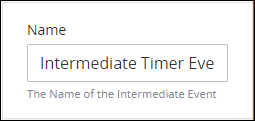
In the Name setting, edit the selected object's name and then press Enter.
Timing Control Panel Settings
When an Intermediate Timer Event is added to a Process model, it is initially configured with a default duration of one (1) hour before it triggers. If this timing does not meet your needs, you can configure the event using one of three timer options:
Duration: Set a specific amount of time (minutes, hours, days, weeks, or months) for how long the process should pause before the event triggers.
Date/Time: Trigger the event at a specific calendar date and time.
Cycle: Configure the event to trigger repeatedly at defined intervals.
Select the timer option that best fits your process needs to control when the Intermediate Timer Event resumes the workflow.
Set the Timing Control
Follow these steps to set the timing for an Intermediate Timer Event object:
Select the Intermediate Timer Event object.
Click the Show Configuration button
 to view the Configuration panel.
to view the Configuration panel.Expand the Timing Control panel.
.png)
Select one of the following options to set the timer control:
Duration: This is the default timer setting. Use it to define how long the process should pause before the Intermediate Timer Event triggers. By default, the timer is set to 1 hour, and you can select from one of the available time units:
Minute
Hour (default)
Day
Week
Month
Date/Time: Use this option to trigger the Intermediate Timer Event at a specific calendar date and time.
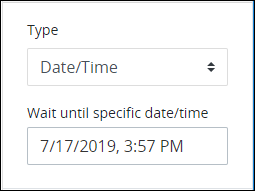
This displays the Wait until specific date/time setting, where you can configure the exact date and time the event should trigger.
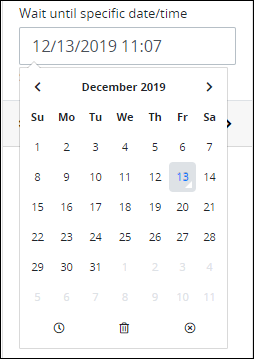
Cycle: Use this option to trigger the Intermediate Timer Event at recurring time intervals.
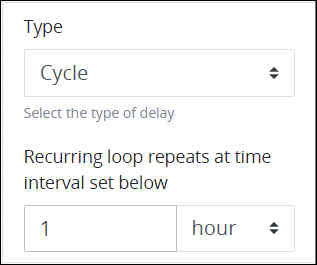
This displays the Recurring loop repeats at time interval set below setting, where you can configure how often the event should repeat (e.g., every day, week, or month).
Documentation Panel Settings
Use this field to describe the purpose of the object and how it functions within the Process. This information does not impact Case execution but can support Process model maintenance by documenting configuration details or design intent.
You can edit the description using the What-You-See-Is-What-You-Get (WYSIWYG) rich text editor. A Process's entered documentation displays by selecting the View Documentation icon for that Process.
Edit the Object Documentation
Follow these steps to edit the description for an object:
Select the object from the Process model.
Click the Show Configuration button
 to view the Configuration panel.
to view the Configuration panel.Expand the Documentation panel. The Description setting displays.
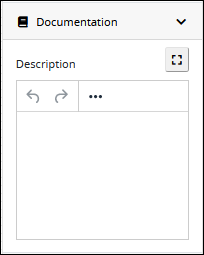
In the Description setting, edit the information to display when viewing documentation for this object and then press Enter. Alternatively, use the What-You-See-Is-What-You-Get (WYSIWYG) rich text editor to stylize your text by clicking the More icon
 .
. 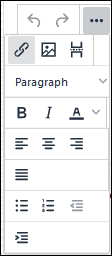
Follow these guidelines to use the WYSIWYG rich text editor to stylize your text:
Undo changes: Click on the
 icon to undo the last action.
icon to undo the last action.Redo changes: Click on the
 icon to redo the last undone action.
icon to redo the last undone action.Insert/Edit Link: Click on the
 icon to convert the selected text into a hyperlink. Follow these steps to create a hyperlink:
icon to convert the selected text into a hyperlink. Follow these steps to create a hyperlink: Select the required text from the Rich Text control.
Click on the
 icon. The Insert/Edit Link screen displays.
icon. The Insert/Edit Link screen displays. 
In the URL setting, enter the destination URL.
In the Text to display setting, edit or enter the text displayed in the Rich Text control.
In the Title setting, enter the text to display when a user hovers over the displayed text.
From Open link in… drop-down menu, select one of these options:
New window: Select this option to open the destination page in a new browser window.
Current window: Select this option to open the destination page in the current browser window.
Insert/Edit Image: Click on the Insert/Edit Image icon
 to insert an image. Follow these guidelines:
to insert an image. Follow these guidelines: Click on the Insert/Edit Image icon
 .
. The Insert/Edit Image screen displays:

In the Source setting, enter a URL for the image.
In the Alternative Description setting, enter the text to display if the source URL of the image is not accessible.
In the Width setting, enter the maximum width for the image.
In the Height setting, enter the maximum height for the image.
Toggle the Constrain Proportions icon
 to maintain the width-height ratio of the image to its original proportion.
to maintain the width-height ratio of the image to its original proportion. Click Save.
Insert Page Break for PDF: Click on the Insert Page Break for PDF icon
 to insert a page break when a PDF document is created for this documentation if your browser supports this feature.
to insert a page break when a PDF document is created for this documentation if your browser supports this feature. Format text: Follow these guidelines to format text:
Headings: From the Paragraph/Formats menu, select Headings and then select a heading size.
Bold: Do one of the following:
From the editor toolbar, select the
 icon.
icon.From the Paragraph/Formats menu, select Inline and then Bold.
Italics: Do one of the following:
From the editor toolbar, select the
 icon.
icon.From the Paragraph/Formats menu, select Inline and then Italic.
Underline: From the Paragraph/Formats menu, select Inline and then Underline.
Strikethrough: From the Paragraph/Formats menu, select Inline and then Strikethrough.
Superscript: From the Paragraph/ Formats menu, select Inline and then Superscript.
Subscript: From the Paragraph/Formats menu, select Inline and then Subscript.
Code: From the Paragraph/Formats menu, select Inline and then Code.
Paragraph: From the Paragraph/Formats menu, select Blocks and then Paragraph.
Blockquote: From the Paragraph/Formats menu, select Blocks and then Blockquote.
Division: From the Paragraph/Formats menu, select Blocks and then Div.
Preformatted: From the Paragraph/Formats menu, select Blocks and then Pre.
Change text color: Use the Text Color drop-down to change text color. Click on the
 icon. The color palette displays. Do one of the following:
icon. The color palette displays. Do one of the following:Select one of the color swatches from the color palette. The selected text changes to that color.
Click the
 icon to select a custom color from the Color Picker.
icon to select a custom color from the Color Picker.Click the
 icon to reset the text to its default color.
icon to reset the text to its default color.
Align text: Follow these guidelines to align text:
Left align: Do one of the following:
From the editor toolbar, use the
 icon to left-align text.
icon to left-align text.From the Paragraph/Formats menu, select Align and then Left.
Center align: Do one of the following:
From the editor toolbar, use the
 icon to center-align text.
icon to center-align text.From the Paragraph/Formats menu, select Align and then Center.
Right align: Do one of the following:
From the editor toolbar, use the
 icon to right-align text.
icon to right-align text.From the Paragraph/Formats menu, select Align and then Right.
Justify: Do one of the following:
From the editor toolbar, use the
 icon to justify text.
icon to justify text. From the Paragraph/Formats menu, select Align and then Justify.
Insert a bullet list: Use the
 icon to format text as a bulleted list.
icon to format text as a bulleted list.Insert a numbered list: Use the
 icon to format text as a numbered list.
icon to format text as a numbered list.Indent text: Click on the
 icon to increase text indenting.
icon to increase text indenting.Outdent text: Click on the
 icon to decrease text indenting.
icon to decrease text indenting.
Advanced Panel Settings
Edit the Node's Identifier Value
Process Modeler automatically assigns a unique value to each Process node added to a Process model. However, a node's identifier value can be changed if it is unique to all other nodes in the Process model, including the Process model's identifier value.
All identifier values for all nodes in the Process model must be unique.
Follow these steps to edit the identifier value for an Intermediate Timer Event object:
Select the Intermediate Timer Event object from the Process model in which to edit its identifier value.
Ensure that the Configuration panel displays. If not, show it. Panels to configure this object display.
Expand the Advanced panel if it is not presently expanded. The Node Identifier setting displays. This is a required setting.

In the Node Identifier setting, edit the Intermediate Timer Event object's identifier to a unique value from all nodes in the Process model and then press Enter.